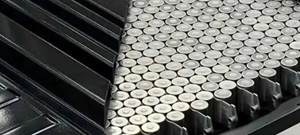Hydrogen theme day of Composites United e.V. is a big success
The European network’s “Hydrogen Storage — Opportunities for Fiber Composites” on Jan. 19, 2021 experienced more than 350 registrations.

Photo Credit: Composites United e.V.
- Event led by CU working group “Multi-Material-Design”
- Presentations discussed R&D for different tanks, materials and processes
- Participants asked for further exchange — to be hosted by CTC Stade on Nov. 18, 2021
More than 350 registrations were counted for the virtual theme day “Hydrogen Storage — Opportunities for Fiber Composites” from Composites United e.V. (CU) held on Jan. 19, 2021. Speakers and guests discussed in detail the possibilities of hydrogen storage and transport. A follow-up event has been announced for Nov. 18, 2021.
The EU wants to be climate-neutral by 2050 — that’s what its “Green Deal” agenda says. The energy transition is an important component in mastering the climate and environmental challenges and reducing emissions of the harmful greenhouse gas CO2. In addition to expanding renewable energies and increasing energy efficiency, alternative and non-fossil fuels will play an important role. Hydrogen is currently considered a promising energy carrier for the future.
The CU working group “Multi-Material-Design,” in cooperation with HZwo e.V. — Saxony Innovation Cluster for Fuel Cell and Hydrogen Technology, invited the industry to a theme day on Jan. 19, 2021. The question of what role lightweight design with fiber composites can play for storing and transporting hydrogen for mobile drive solutions was discussed with composite experts from the fields of engineering, manufacturing and testing.
The organizer and host Dr. Thomas Heber (Cluster Manager CU Ost and Head of the working group) and the virtual co-host Dr. Steffen Kress (CEO of COTESA GmbH) welcomed the speakers and guests to the Zoom conference and were very impressed by the high number of registrations and the corresponding interest. The presentations throughout the day showed how advanced and versatile the research and development activities already are in practice, highlighting in a material- and technology-neutral approach the benefits and disadvantages of different types of tanks, manufacturing processes and materials.
The experts agreed that fiber composites are the most important group of materials for tank systems of hydrogen-powered vehicles and aircraft. Composite pressure tanks are much lighter than metal designs and also have better mechanical properties. Whether hydrogen should be stored in a pressure vessel or a cryogenic tank depends on the specific application. Cryogenic tanks will be of particular interest for aviation in the future due to a better storage ratio in large tanks, while smaller pressure vessels are mainly used in the automotive industry. The potential for fiber composite lightweight design through peripheral components such as piping, structural connections, etc. was also discussed at the event.
Safety standards are a major technical challenge in the use of composites. For the tank as part of the drivetrain, it is important to identify risks and develop safety concepts for both operation and for crash situations. Burst and impact protection, fire safety, explosion protection and leak detection are at the top of the agenda. For comparable vehicle ranges, the use of hydrogen requires significantly larger tank volumes than fossil fuels; ideas for new overall vehicle concepts are needed.
At the end of the theme day, guests had the opportunity to accompany Dr. Steffen Kress on a virtual technology tour around the CORTESA plant in Mochau. Dr. Thomas Heber was pleased about the great interest in the event as well as the many contributions to the discussion, and summarizes: “For a future with lower emissions, it is of great importance to ensure and continuously develop technically faultless and thus safe technologies for the storage and transport of hydrogen. This requires reliable standards for quality, safety and operation — for economic success, the corresponding political and legal framework conditions are therefore also necessary.”
CU reports that during the event, many participants requested a further exchange on this topic and for a follow-up event. The organizers have responded directly to this request and announced the next theme day “Hydrogen Technology — Opportunity for Fiber Composites 2.0” for Nov. 18, 2021, to be hosted by the Composite Technology Center — CTC GmbH in Stade.
Related Content
Braided thermoplastic composite H2 tanks with co-consolidated molded boss areas to fit EV battery space
BRYSON project demonstrates possible designs, automated manufacturing and low permeability concepts, including EVOH liner and novel PPA matrix.
Read MoreComposites end markets: Batteries and fuel cells (2024)
As the number of battery and fuel cell electric vehicles (EVs) grows, so do the opportunities for composites in battery enclosures and components for fuel cells.
Read MoreOptimizing robotic winding of composite tanks and pipes
Pioneer in mandrel-based reinforced rubber and composite products, TANIQ offers TaniqWindPro software and robotic winding expertise for composite pressure vessels and more.
Read MorePolar Technology develops innovative solutions for hydrogen storage
Conformable “Hydrogen in a Box” prototype for compressed gas storage has been tested to 350 and 700 bar, liquid hydrogen storage is being evaluated.
Read MoreRead Next
Next-gen fan blades: Hybrid twin RTM, printed sensors, laser shock disassembly
MORPHO project demonstrates blade with 20% faster RTM cure cycle, uses AI-based monitoring for improved maintenance/life cycle management and proves laser shock disassembly for recycling.
Read MoreCutting 100 pounds, certification time for the X-59 nose cone
Swift Engineering used HyperX software to remove 100 pounds from 38-foot graphite/epoxy cored nose cone for X-59 supersonic aircraft.
Read MoreScaling up, optimizing the flax fiber composite camper
Greenlander’s Sherpa RV cab, which is largely constructed from flax fiber/bio-epoxy sandwich panels, nears commercial production readiness and next-generation scale-up.
Read More












